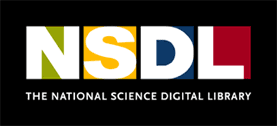Contribute a Resource or Collection
NSDL encourages developers of STEM content, NSF grant awardees, STEM educators and learners, and all other NSDL users and community members to help us enlarge and strengthen the Library. We welcome recommendations concerning digital resources NSDL users have created or discovered on the web, such as activities, lesson plans, web sites, or simulations. We are also eager to hear from organizations or individuals who have created or are interested in creating collections of STEM resources. In NSDL terms, a collection is an assemblage of related digital resources -- usually brought together around a topic or theme, type of resource, audience, or institution -- each with its own URL, and each catalogued by the collection builder or manager.
Benefits of contributing materials to NSDL include:
- Exposure. NSDL marketing and outreach activities promote access to resources and collections.
- Discovery. NSDL search and browse mechanisms enable users to locate appropriate collections and resources.
- Service. Making materials available through NSDL encourages sharing and reuse of resources within STEM education and research communities.
- Support. Access to technical assistance and tools for collection development and management are available from NSDL.
- Recognition. NSDL clearly attributes collections and the resources within them to their providers.
There are two methods for contributing materials to NSDL, described below. Which you should use depends on the number of resources you wish to contribute and whether they constitute a collection.
1. Contributing one or several individual resources
This is quick and easy to do. The steps are as follows:
- Ask yourself whether the resource is appropriate for NSDL. Does it support teaching, learning, or research in science, technology, engineering, or mathematics? Is it scientifically sound, technologically reliable, and easy to use? (See the NSDL Collection Development Policy, particularly the sections “Collection Scope” and “Quality Guidelines.”)
- Complete the Recommend a Resource form, providing the URL to the resource and descriptive information about it.
You will be notified if the resource you are recommending is accepted for inclusion in the Library. If it is accepted, the descriptive information you have provided via the Recommend a Resource form will be reviewed and edited. It will become part of NSDL’s catalog record for the resource, which will be viewable by Library users. NSDL may create an archived copy of the resource. (For details of these policies see the NSDL Collection Development Policy, particularly the “Terms of Participation” section.)
2. Contributing a collection
As mentioned above, NSDL uses the term collection to designate a group of digital resources that have something in common -- a shared topic, intended audience, genre or type (e.g., demonstrations, videos, e-prints), the institution that has sponsored their creation or review, or another shared characteristic. Each resource in a collection has its own URL and has been, or can be, individually catalogued. Examples of collections include the Analytical Sciences Digital Library, arXive.org, and the Bridge-NOAA Educational Resources Collection. If you are interested in creating a collection for inclusion in NSDL, see the Collection Development Blueprint.
Contributing an existing collection to NSDL involves working with us to enable NSDL users to discover and access individual resources in the collection through a search across the multiple collections that comprise NSDL. Achieving this goal requires some measure of time and effort; the collection must have the capacity to provide us with NSDL-compatible descriptive information (or metadata) about each of its resources.
The tasks involved in contributing a collection to NSDL are outlined below. These tasks may be accomplished in various orders or in parallel.
- Ask yourself whether your collection is appropriate for NSDL. Do resources in your collection -- or a significant portion of them -- support teaching, learning, or research in science, technology, engineering, or mathematics? Are they scientifically sound, technologically reliable, and easy to use? (See the NSDL Collection Development Policy, particularly the sections “Collection Scope” and “Quality Guidelines.”) If you believe so, please contact us to initiate discussion.
- Consider the descriptive information (metadata) you have about individual resources (items) in your collection, or your capacity to create such metadata. The NSDL_DC Metadata Guidelines provide a review of what metadata is, how it works in NSDL, what formats we can work with, and how to create the NSDL_DC metadata that is optimal for participation in the Library. If you need to create metadata, there are cataloging tools available within the NSDL community, including the Collection Workflow Integration System, or CWIS, and the NSDL Collection System, or NCS. To learn more about the NCS, contact us.
- Familiarize yourself with NSDL’s policies. The “Terms of Participation” section of the NSDL Collection Development Policy outlines the rights of resource and metadata creators; how NSDL may treat your metadata in terms of presentation, redistribution, and use; and the presentation and archiving of your content.
- Provide NSDL with metadata about your resources. Contributing a collection to NSDL means making your item-level metadata accessible to NSDL systems and users. Collection builders can share metadata with NSDL by 1) using an Open Archives Initiative (OAI) server; 2) programmatic means, via an application programming interface (API); 3) by using a cataloging tool that talks directly to NSDL. See Sharing Metadata with NSDL.
- Register your collection with NSDL. Complete the Submit a Collection form, providing the URL of your collection’s home page, other information for a catalog record describing the collection as a whole, and a contact person.
- Provide a collection brand or logo. This is a small digital image, 100 pixels wide by 30 pixels tall or in that ratio, that we will use in displaying items from your collection when they appear in NSDL search results. Please see our Collection Branding Guidelines for file format and other specifications.
- Maintain the collection. After a collection has been contributed to NSDL, it is our expectation that it will be kept up to date, with nonworking resource URLs weeded out and/or replaced and metadata titles and descriptions corrected as needed.
